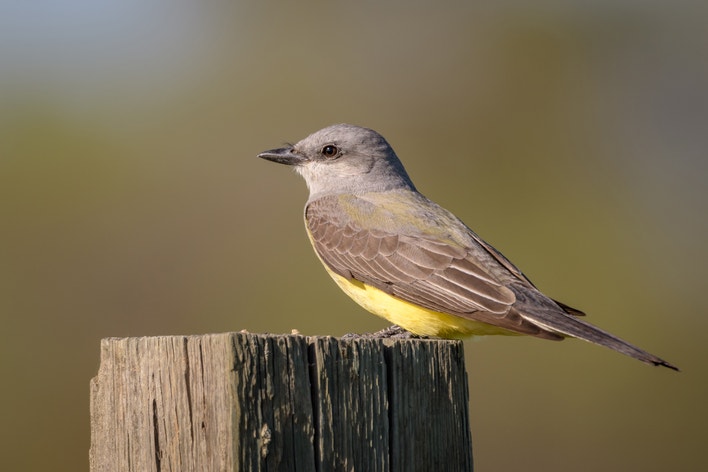Western Kingbird
At a Glance
In open country of the west, the Western Kingbird is often seen perched on roadside fences and wires, flying out to snap up insects -- or to harass ravens, hawks, or other large birds that stray too close to the kingbird's nest. Spunky and adaptable, this flycatcher has adjusted well to advancing civilization within its range. It frequently builds its nest where wires attach to utility poles, and may be seen tending its young there even along busy city streets.
All bird guide text and rangemaps adapted from Lives of North American Birds by Kenn Kaufman© 1996, used by permission of Houghton Mifflin Harcourt Publishing Company. All rights reserved.
Category
Perching Birds, Tyrant Flycatchers
IUCN Status
Least Concern
Habitat
Arroyos and Canyons, Desert and Arid Habitats, Fields, Meadows, and Grasslands, Shrublands, Savannas, and Thickets, Urban and Suburban Habitats
Region
California, Eastern Canada, Florida, Great Lakes, Mid Atlantic, New England, Northwest, Plains, Rocky Mountains, Southeast, Southwest, Texas, Western Canada
Behavior
Direct Flight, Hovering
Population
30.000.000
Range & Identification
Migration & Range Maps
Often migrates in small flocks. A few stray eastward every fall, appearing along Atlantic Coast, some of these birds moving south to winter in Florida.
Description
8-9" (20-23 cm). Yellow belly, gray chest and head (with darker mask). Notice black tail with narrow white outer edges. Compare to other yellow-bellied kingbirds, crested flycatchers.
Size
About the size of a Robin
Color
Black, Gray, White, Yellow
Wing Shape
Rounded
Songs and Calls
A loud, sharp kit. Various chattering notes.
Call Pattern
Flat, Rising, Undulating
Call Type
Chirp/Chip, Trill, Whistle
Habitat
Semi-open country, farms, roadsides, towns. Breeds in open terrain with trees to provide nest sites; may be in farmland, groves or streamside trees in prairie country, semi-desert scrub; avoids true desert. Also in towns; where trees are lacking, will nest on artificial structures. Where ranges overlap, typically in more open country than Eastern or Cassin's kingbirds.
Sign up for Audubon's newsletter to learn more about birds like the Western Kingbird
Behavior
Eggs
3-5, rarely up to 7. Whitish, heavily blotched with brown, lavender, and black. Incubation is mostly or entirely by female, about 18-19 days.
Young
Both parents feed nestlings. Young leave nest about 16-17 days after hatching.
Feeding Behavior
Forages mostly by watching from a perch and then flying out to snap up insects in its bill. May perch low or high; may catch insects in mid-air, or may hover and then drop to the ground to catch them.
Diet
Mostly insects. Feeds on a wide variety of insects, especially wasps, bees, beetles, and grasshoppers, also flies, true bugs, caterpillars, moths, and many others. Also eats some spiders and millipedes, and regularly eats small numbers of berries and fruits.
Nesting
Male defends territory by singing, giving "dawn song" incessantly at first hint of daylight. In courtship, male performs flight display, rapidly flying up and down in vertical zigzags, giving rapid sputtering calls. Nest site varies, usually in tree in vertical fork or on horizontal limb, 15-30' above ground. Also often nests on utility poles, sometimes on building ledges or towers, in empty sheds, on cliff ledges, or in abandoned nests of other birds. Nest (probably built by both sexes) is a cup of grass, weeds, twigs, plant fibers, lined with finer materials such as feathers, plant down, animal hair, bits of paper.
Conservation
Conservation Status
Has expanded breeding range eastward and increased in numbers during 20th century. Population now stable or possibly still increasing.
Climate Threats Facing the Western Kingbird
Choose a temperature scenario below to see which threats will affect this species as warming increases. The same climate change-driven threats that put birds at risk will affect other wildlife and people, too.










